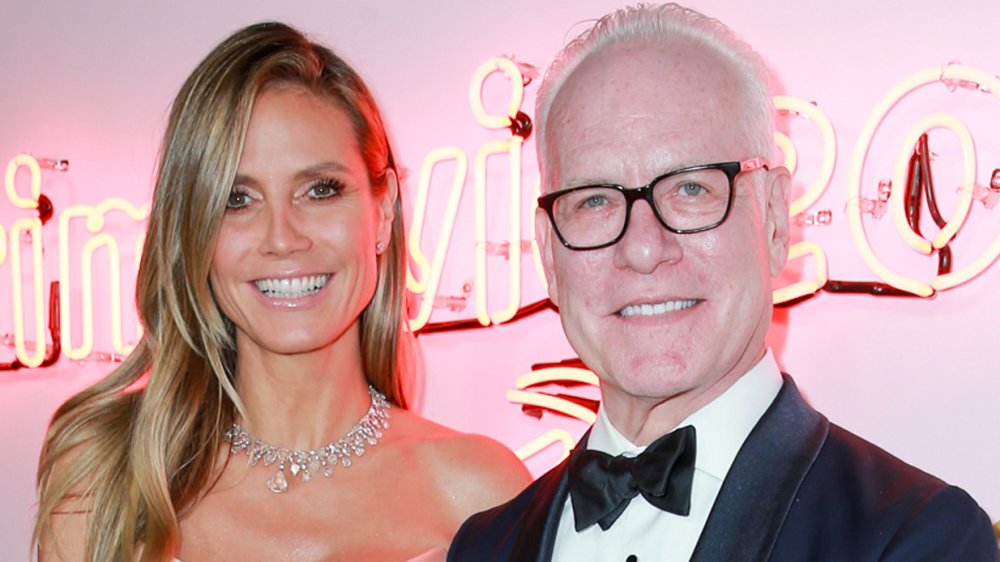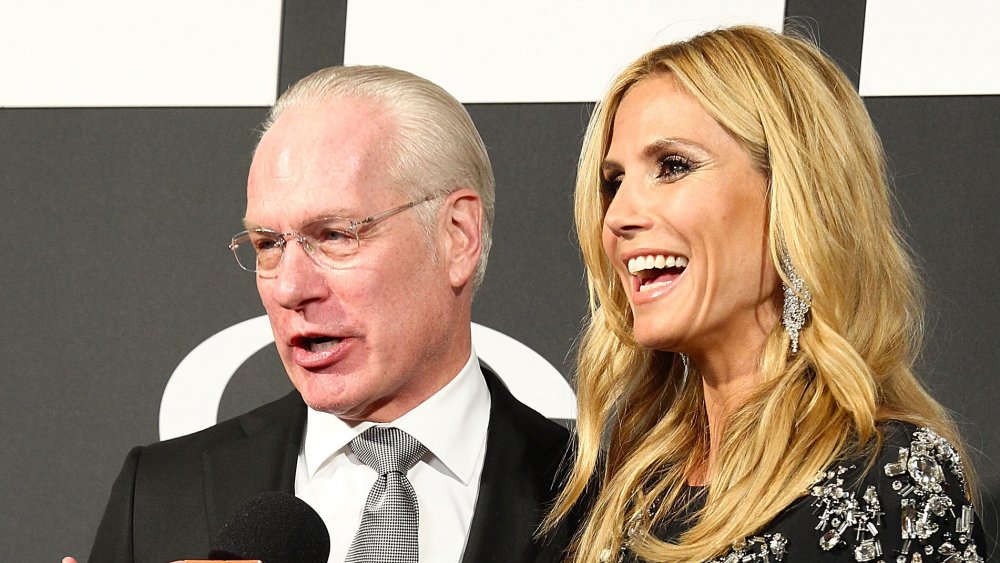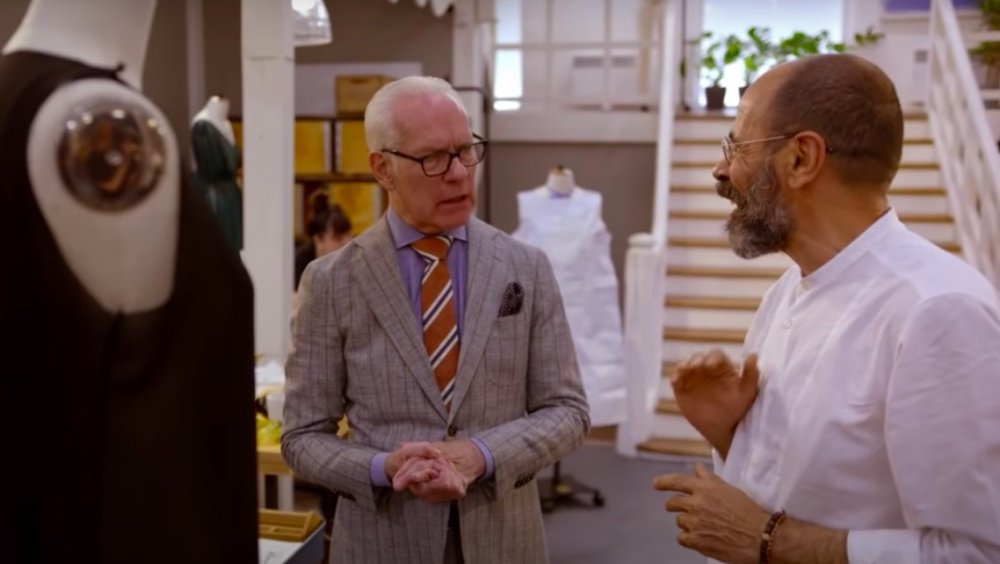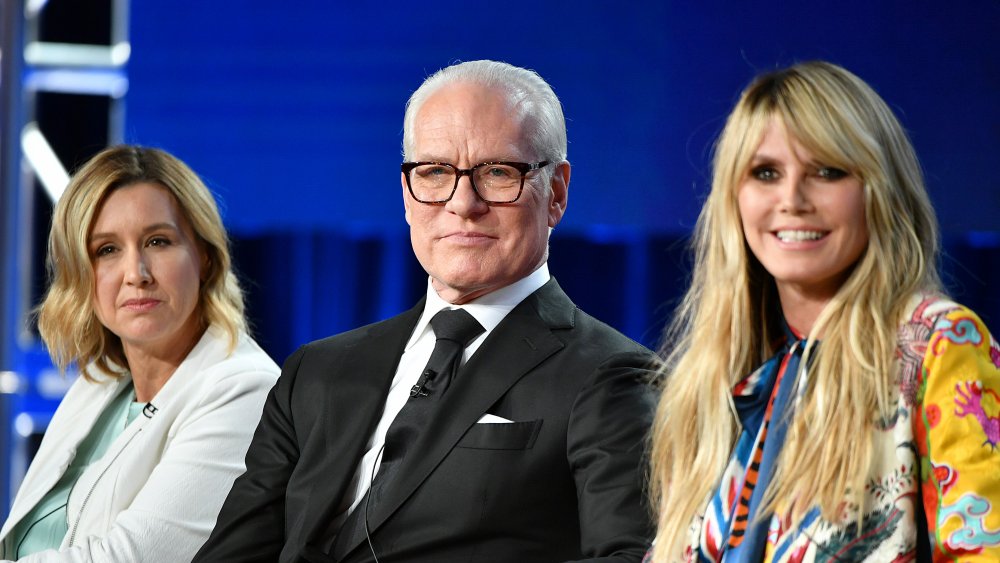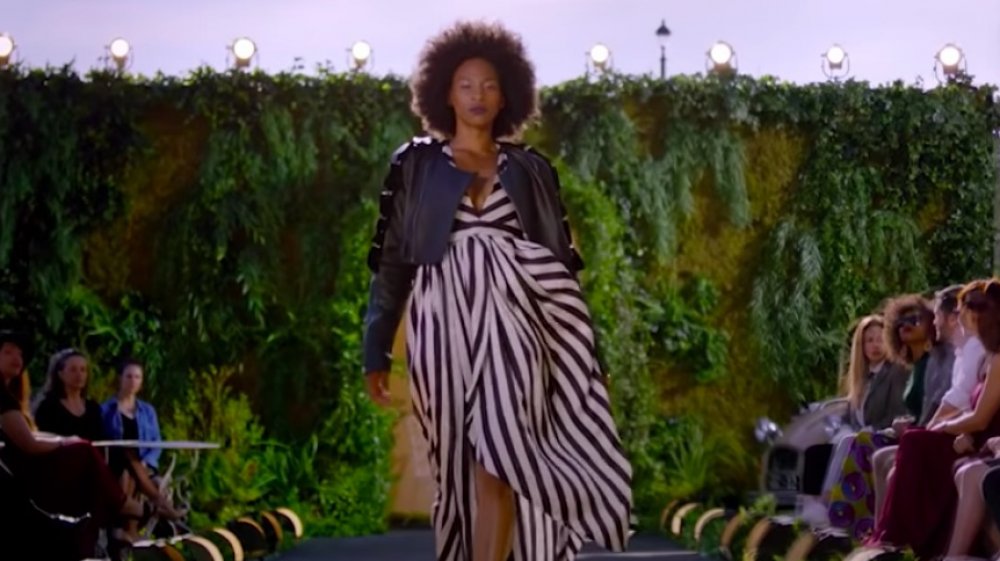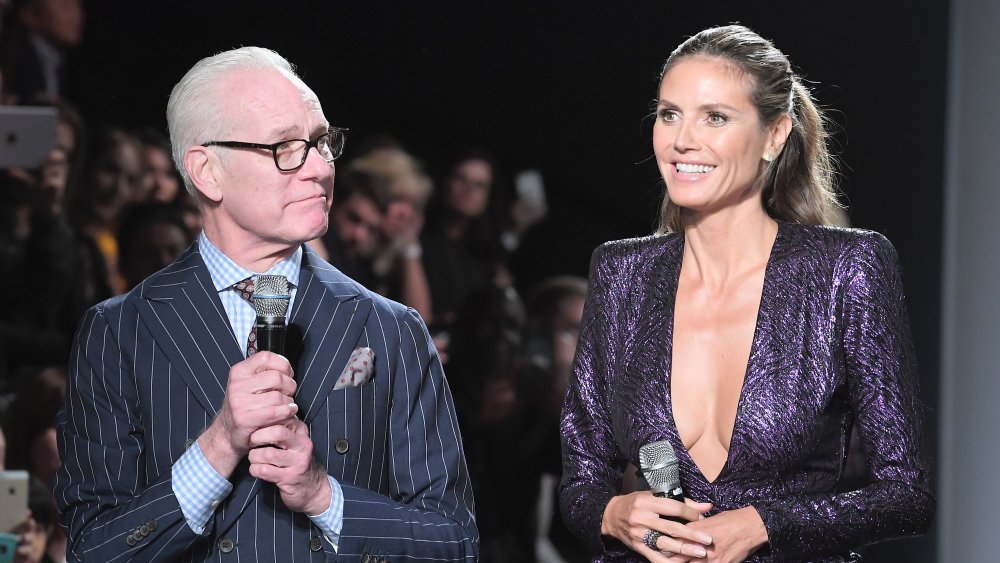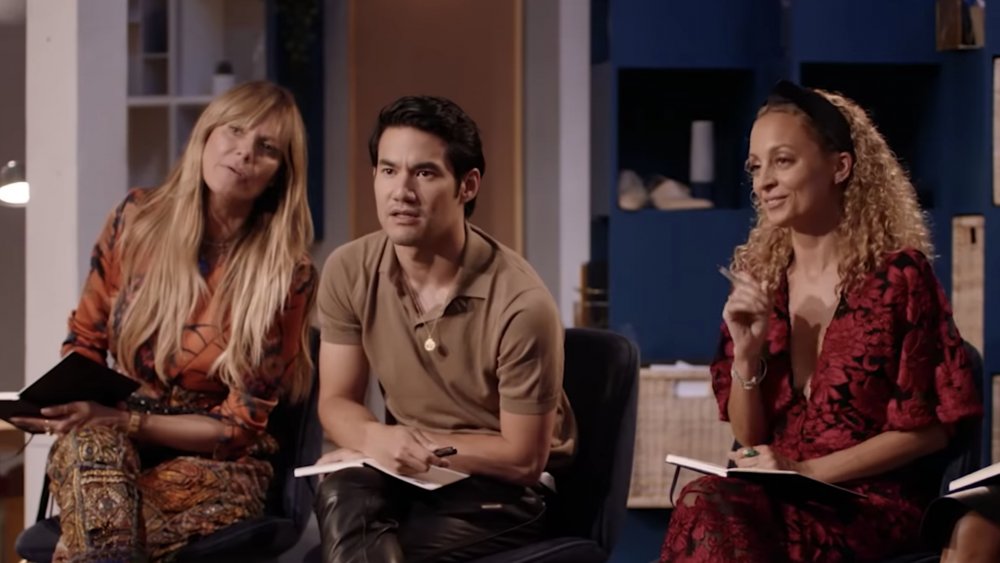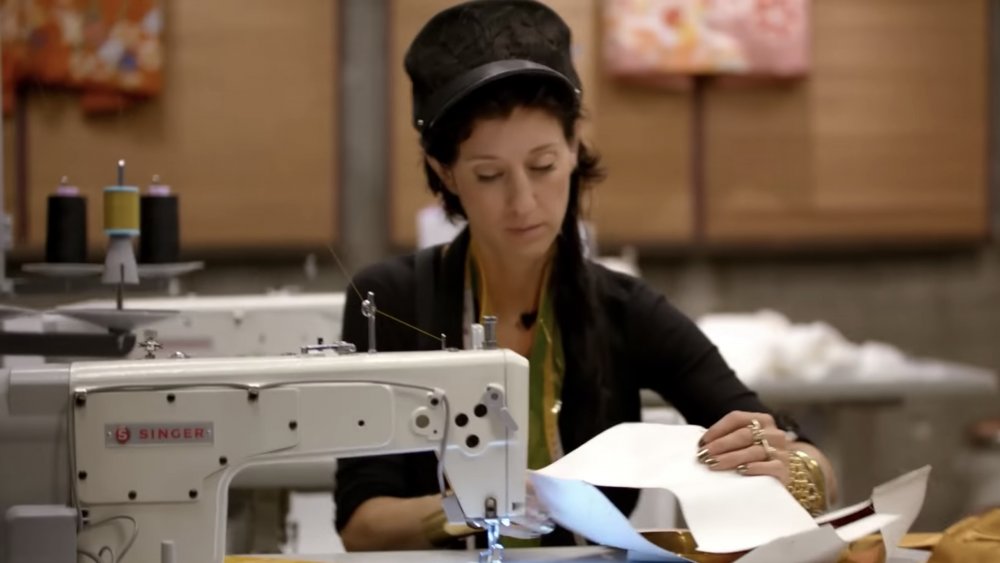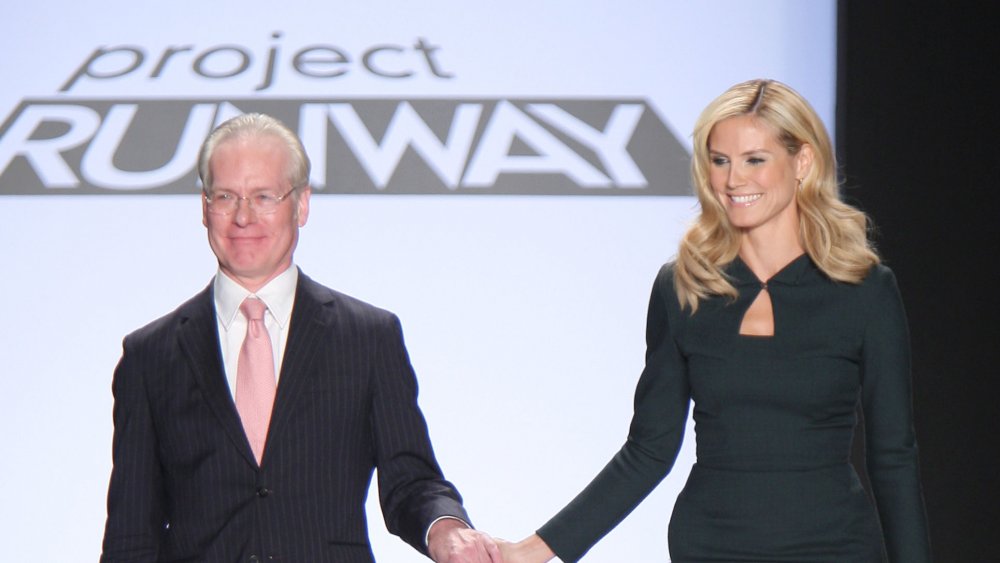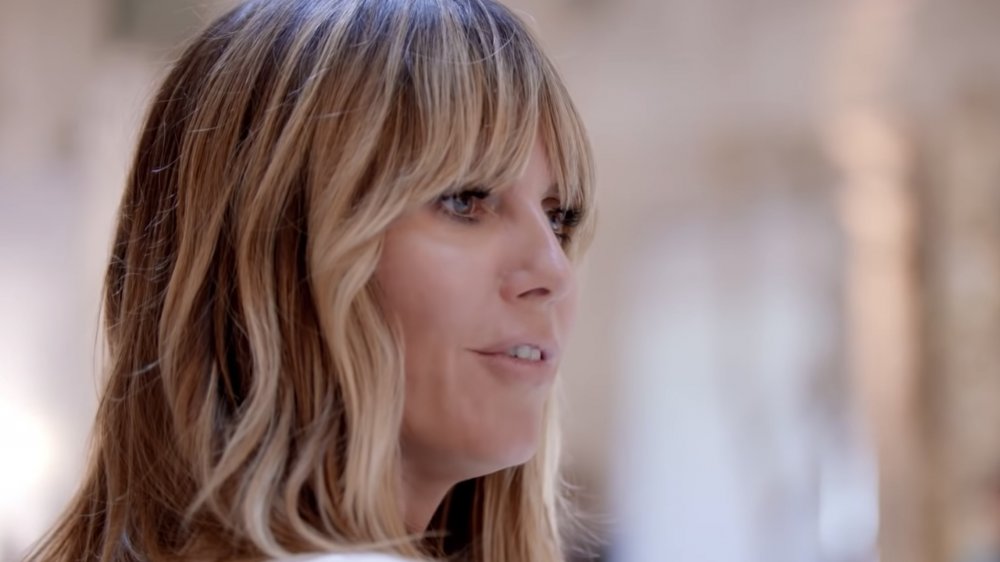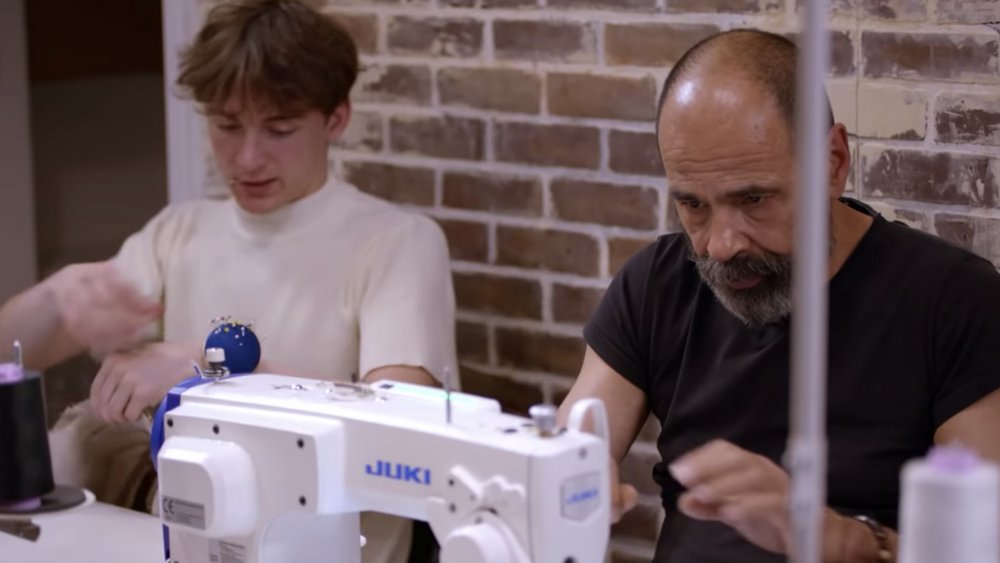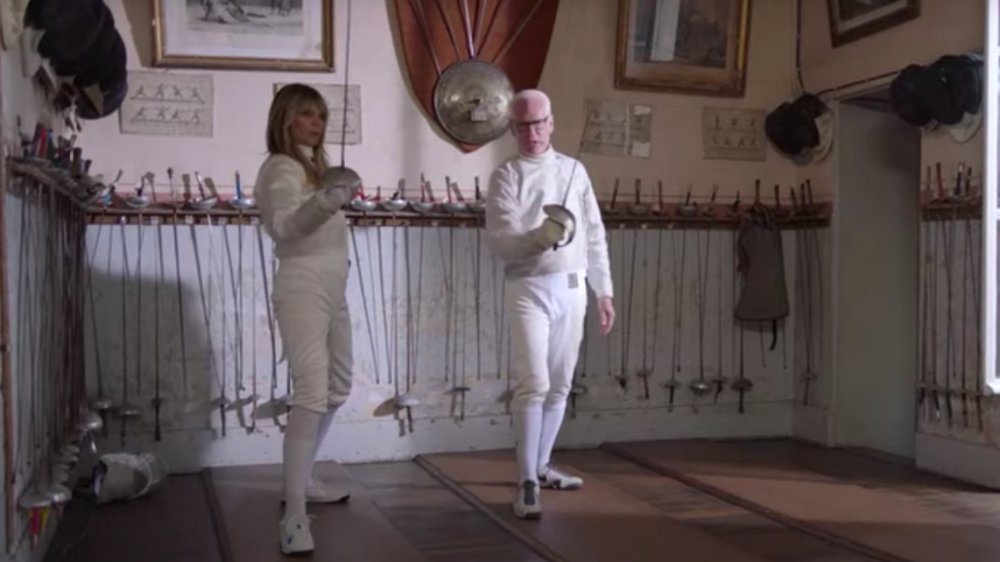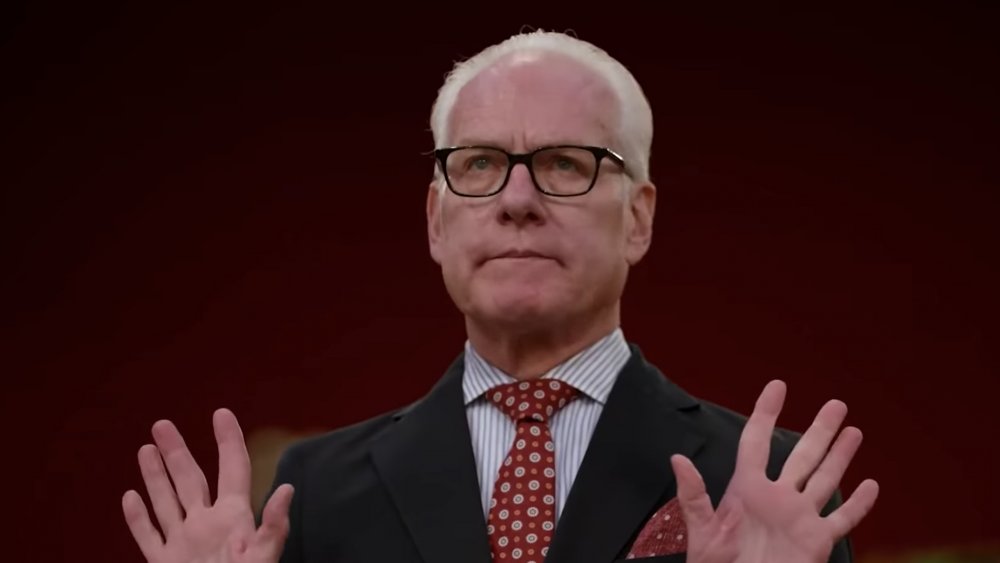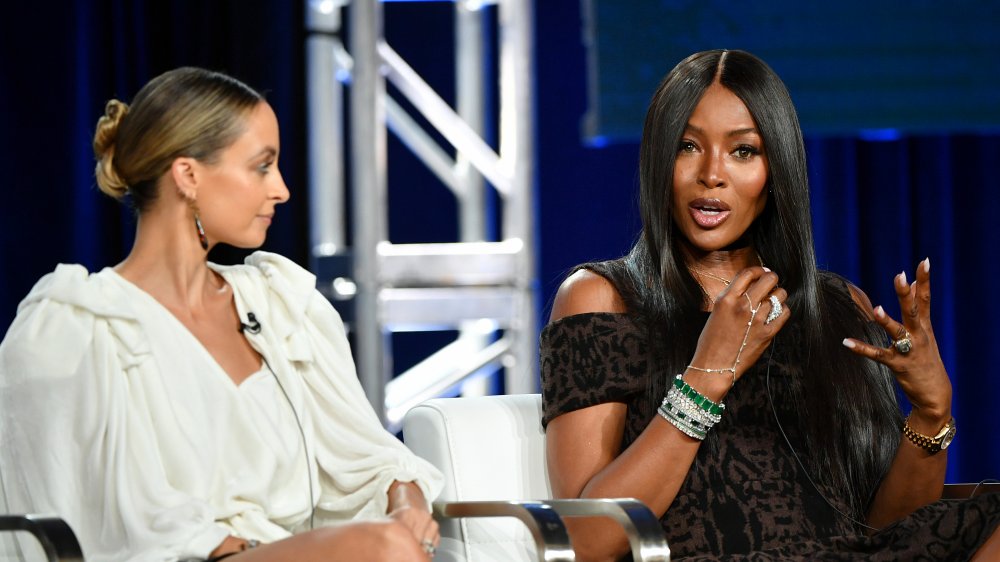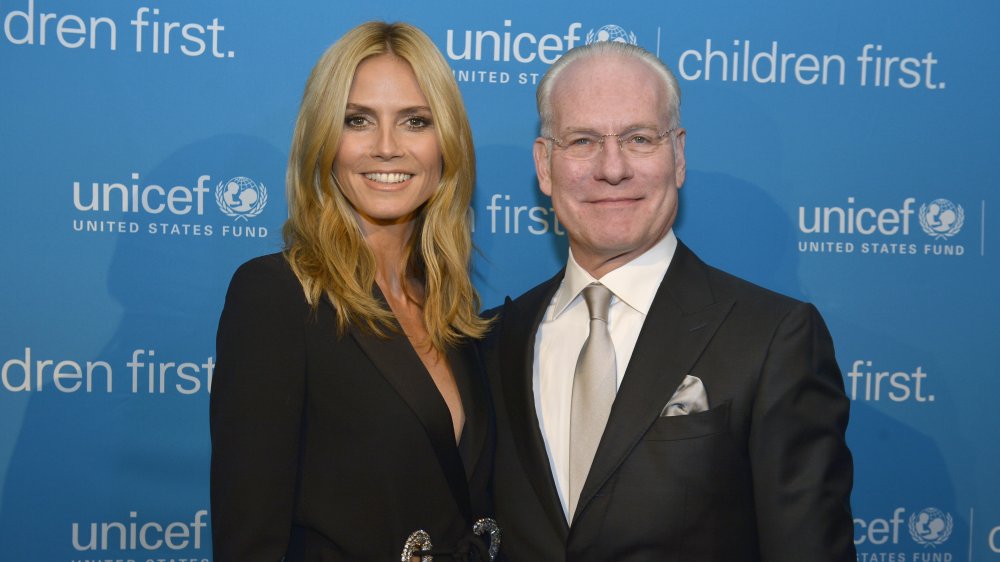The Untold Truth Of Making The Cut
Making the Cut's Heidi Klum and Tim Gunn brought a fashionable edge to reality TV with the 2004 debut of Project Runway, a competition series that pitted aspiring fashion designers against each other. When the duo announced they were leaving the show after its 16th season (via Deadline), new TV project Making the Cut was revealed — a series for Amazon Prime Video that didn't stray far from the Project Runway template but brought a few additions.
At the end of the season, the winning designer earns more than just respect — the grand prize is a million dollars to launch that designer's brand. The show also offers a kind of global reach that Project Runway never had, filming in Paris and Tokyo, as well as premiering in more than 200 different countries.
Gunn and Klum may be "an iconic pop culture duo," to quote Amazon Studios head Jennifer Salke, but there's a lot for fans to learn about their Amazon TV series. Read on to discover the untold truth of Making the Cut.
Why Heidi Klum and Tim Gunn reunited for Making the Cut
Fans of Project Runway were shocked when Heidi Klum and Tim Gunn left the show after 16 seasons in September 2018. In her announcement bidding "Auf Wiedersehen" to Project Runway (via Entertainment Weekly), Klum revealed that she and Gunn would be joining forces for a new show to stream on Amazon Prime Video, Making the Cut. The inevitable question was why the two would risk exiting a successful franchise to launch an untested new show.
Gunn provided an answer during an interview with the New York Post, explaining they had grown dissatisfied with the direction of Project Runway. "Heidi and I have wanted to make changes to Project Runway for quite a while," he said. "We were joined in that desire by the Project Runway showrunner for the last eleven seasons, an incredible woman by the name of Sara Rea. And the network wouldn't budge — they said 'This is a success, people like the format, we're not going to change anything.'"
Their new show, Gunn explained, would be more than just "a sewing competition," and would focus on how a designer can take the next step toward building a global brand.
How Making the Cut is different from other design shows
After Tim Gunn and Heidi Klum inked a deal with Amazon Studios to host Making the Cut, Amazon Prime Video debuted the show in late March 2020. Discussing what sets their new show apart from their earlier one, Gunn told The A.V. Club the goal was a show that was "more relevant to the industry." He explained, "It's much more than talking about a pretty dress; it's talking about what is the vision, who is the customer, what's your distinctive point of view?"
In that same interview, Klum was downright dismissive of Project Runway, describing the show as "a silly competition." Making the Cut, she explained, would be "looking for a brand, something that can sustain, something that will hopefully be loved and enjoyed around the world."
Making the Cut sought out designers who had more than just talent and creativity, they explained; the show was looking for people with vision, who had the capacity to take their design skills to the next level.
How Tim Gunn and Heidi Klum spot a winning design on Making the Cut
Women's Wear Daily shared a video of Tim Gunn and Heidi Klum, along with Making the Cut showrunner Sara Rea, discussing their Amazon Prime Video series. Among the questions posed to the trio was what makes a winning design? Joking that "we have one judge here," Gunn threw the question over to Klum. "For me, it's something that is an amazing staple that we all want to have that has a fashion twist," she replied.
Making the Cut, Klum explained, gives each of the designers the opportunity to design two distinct looks for each runway show. "One is more outrageous, over the top, it could be avant-garde, it could be for a specific assignment that we give them," she said. In addition to that "out-there" design, the other is meant to be "more of a sellable item, something that we can then buy," added Klum.
While those clothing items must be practical, Klum pointed out that Making the Cut is still a competition focused on design. No matter what the designers cook up, she insisted, the clothing could not be bland.
The "shoppable experience" that makes Making the Cut stand out
Given that Making the Cut is produced by Amazon Studios, the entertainment arm of the world's largest online retailer, it shouldn't be surprising that the show also has a retail element built into its format. In fact, the same day that a new episode drops, the winning design is made immediately available for purchase. Amazon has made the process as seamless as possible; on the Making the Cut page on the Amazon site, viewers were once greeted by two buttons: one to watch the show and another to shop for the items.
However, as Decider pointed out, viewers are warned that shopping before watching the episode is akin to receiving a spoiler, as browsing will reveal which design took the prize that week. Amazon has recognized that, however, and the Making the Cut online store is hidden beneath a button reading "#Spoilers."
Decider also did a cost comparison of the winning designs from the first two episodes, reporting they were all reasonably priced. Items ranged from $44.90 to $64.90. However, the outlet also cautioned anyone wanting to make a purchase to move quickly, as there were limited quantities of each.
The best advice Making the Cut's Heidi Klum and Tim Gunn can offer aspiring designers
In a video interview with Women's Wear Daily, Making the Cut stars Heidi Klum and Tim Gunn were joined by showrunner Sara Rea, and they shared their best advice for aspiring designers looking to launch a career in fashion. "Know who you are," advised Gunn, adding, "And I mean know who you are, and love what you do."
They were also questioned about the kind of trends they enjoy seeing from the new crop of designers. For Klum, one thing she'd like to see in future fashion is "more sustainability." She explained, "I think the designers really have an amazing opportunity to think more about our planet and how, for example, the fabrics are being colored, how they're being produced..."
A key objective of the show, added Rea, is to inspire young designers to pursue their dreams of entering the fashion industry. She hoped viewers would feel like they too could achieve their fashion design goals no matter where they are in life after watching the series.
Making the Cut enlisted a heavyweight roster of fashionista judges
When it came time to cast the roster of judges who'd be evaluating the contestants on Making the Cut, Amazon Studios did not hold back.
As Deadline reported in 2019, sitting on Making the Cut's judging panel was supermodel Naomi Campbell (who is also the show's consulting producer); fashion designer, actress, and former reality TV star Nicole Richie; former Vogue Paris editor in chief Carine Roitfeld; fashion designer Joseph Altuzarra; and designer/influencer Chiara Ferragni, who was featured as a guest judge on the 13th season of Project Runway.
Asked about her "brutally honest" critiques on Making the Cut, Campbell told Nylon she was simply telling it like it is and speaking her truth. "For me, whether the cameras are there or not, that's what I would say. It's not about reality TV; it's reality to me," she explained. "It's someone's life in your hands that you have an opportunity to give a platform to and to show their creativity. You don't want to play with that."
Why some TV critics found Making the Cut to be "sew-sew"
By and large, television critics did not seem to be overly impressed by Making the Cut. In its review, TV Guide found the show to be "a sew-sew rework" of Project Runway. While Making the Cut essentially follows the same format as the earlier show, TV Guide griped that what makes the show different from Project Runway neither improved nor weakened Making the Cut's concept. Rather, it was just different.
Meanwhile, the National Post described Making the Cut as "a serious-minded and apparently earnest attempt to mint a genuine fashion-world superstar, a process that manages to leach much of the fun out of a formula that already has entertainment and education entwined in its DNA." The Post also pointed to the show's "lost and confusing judging process" and the irony that a show meant to encourage fledgling designers to believe their dreams are within reach instead wound up feeling "inaccessible."
The Guardian took an even more savage swipe at Making the Cut, complaining that it "doesn't quite hold together as a gripping competition" while pointing to an unexpected "brutality to the judging."
Why there would be no Making the Cut without Project Runway
In hindsight, Project Runway was trailblazing television. When the show first debuted in 2004, it marked the first time that an American Idol-style competition series enveloped the world of fashion, with designers vying against one other while a panel of judges weighed in.
Looking back at his earlier show, Making the Cut's Tim Gunn admitted that the Amazon show owed a debt to its predecessor. "To be perfectly honest about it, perfectly blunt, Making the Cut wouldn't have happened without Project Runway," Gunn said at the January 2020 Television Critics Association press tour, according to Entertainment Tonight. However, he also viewed Making the Cut as superior, and he offered an analogy. "In my role as a teacher for most of my life, I would say that Project Runway is the undergraduate program and Making the Cut is the graduate and PhD program," he explained.
Gunn elaborated that, unlike Project Runway, Making the Cut is focused on how the designs made for each episode fit into the contestants' brands, as reported by Associated Press.
What Heidi Klum believes makes Making the Cut different
One of the key points that Making the Cut tries to get across to viewers is that fashion may be fueled by creativity, but, at the end of the day, it's still a business. It's this focus, Heidi Klum told The Hollywood Reporter, that differentiates the show from her earlier one, Project Runway.
"I'm really trying to straddle the artistry of fashion design and the commerce part of it," she explained. "When you're online and you're watching your favorite show, which is hopefully going to be ours, you'll have the commerce aspect for the first time. When you see a design that you actually love, you can buy it."
This added aspect, she explained, works well for both consumers and designers. She went on, "We never had that aspect where we could actually help the designers to really branch out into the real world like this on Project Runway."
Why global branding is key to Making the Cut
Another big factor that sets Making the Cut apart from Project Runway is the show's focus on creating a global fashion brand. Speaking with Refinery29, Tim Gunn explained why he and Heidi Klum felt that having the contestants think about their designs in terms of a brand took the concept of a fashion design competition to a whole new level.
"We did not want to judge these individuals on just a case-by-case scenario," Gunn explained. "We didn't want to just be like, Okay, here's your challenge. You were the best and you were the worst one — you're out. We wanted to give them the opportunity to redeem themselves by speaking to us and explaining possibly why their design came out the way it came out."
Klum added that it's all about the designers' brands. She believes this aspect of Making the Cut provides an a better experience for the viewer. "It was different on Project Runway, because there wasn't the same level of support, nor was there, in most cases, the same level of experience," she said.
Heidi Klum and Tim Gunn cut loose in Making the Cut's YouTube series
While the competition element of Making the Cut brings about plenty of drama and tension, Heidi Klum and Tim Gunn also embarked on some fun adventures in a YouTube series accompanying the show. Dubbed Short Cuts, the online series showcased a more lighthearted side of the two.
One episode, for example, found the pair in Paris — which Gunn reminded viewers is "the birthplace of style" — walking arm in arm down a street before winding up at a chic sidewalk cafe. Klum even demonstrated some of the French she's retained over the years. Among the words she recalled was the French translation for "air mattress," although she admitted she couldn't remember why she knew the term.
In another episode, Gunn revealed his favorite sport: fencing. In fact, he admitted to being "a fencing addict." He shared his passion for fencing with Klum, inviting her to participate. He joked to the cameras, "Finally I can teach her something."
How a fashion critic ranked Making the Cut's winning designs
After the first episode of Making the Cut debuted, Los Angeles Times fashion critic Adam Tschorn started reviewing each episode's winning design. The premiere episode's competition was won by Esther Perbandt, a designer based in Berlin, who designed a little black dress with a plunging, V-shaped neckline that Tschorn lauded as "a utility player with broad appeal." The second episode's winner was also Perbandt, whose winning design was a pair of high-waisted pants paired with a black vest that Tschorn described as looking as if it had "taken up with an impossibly shrunken Goth cheerleader's uniform."
In fact, Tschorn seemed to be more taken with a design from that episode that didn't win: designer Ji Won Choi's white mini-dress. Even though the dress wasn't declared the winner, it nonetheless made it onto the Amazon retail portal, he reported, "at the behest of an Amazon Fashion executive who took in the show."
Making the Cut designers were "terrified" of this judge
While Tim Gunn and Heidi Klum have spoken extensively about Making the Cut, what was the experience like for the designers competing on the show? Jonny Cota, the designer who won the show's fourth episode, shared his perspective in an interview with The Daily Front Row. According to Cota, the most frightening thing may have been facing supermodel Naomi Campbell and her often blistering critiques. "I was absolutely terrified of Naomi at the beginning," Cota admitted. "I would stutter my sentences. My palms would get sweaty. I wasn't terrified because she's an incredible model, I'm terrified because she tells it like it is."
Designer Ji Won Choi also opened up about her experience on Making the Cut, and told Variety she was likewise fearful of Campbell. "I was trembling the entire time," said Choi. "She's the scariest person to be in front of, and she's the most perfect person I've ever seen. She would just stare down at me whenever I was in front of the judges pitching my brand and explaining my looks. I've never been so terrified."
What Tim Gunn and Heidi Klum hope viewers take away from Making the Cut
Asked what she and Tim Gunn hope that viewers take away from Making the Cut, Heidi Klum listed two things: joy from simply watching the show and an education on the fashion industry. "I think it explains to you and any people how fashion actually happens, the creativity, the process, plus the business side of it, how it actually comes about," Klum told The A.V. Club.
Klum also felt that Making the Cut would provide viewers with an insiders' look at fashion that would lead to a greater appreciation of the clothing they wear. "And when you put something on, it gives you a little bit more of a sense of like, 'Wow,' what all went behind making this jacket, for example. Someone had to pick the fabric, the cut, etc., etc., all these things."
Meanwhile, Gunn was hopeful that the show would "expand people's vocabulary" in terms of how they discuss clothing. "I mean, we all need clothes," he explained. "They're part of our lives."
